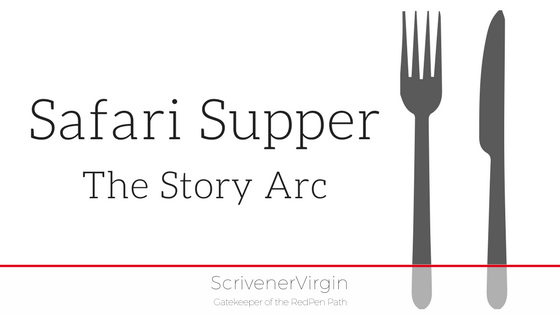Safari Supper – The Story Arc
Hoorah! My story arc is written.
I’ve been waiting for ideas to come but today, determined to make progress, I opened my Scrivener project ‘Safari Supper’ and just started typing. The words flowed. It never ceases to amaze me how, faced with a blank page, given a prompt, I can write. What I write comes from who knows where. Hence my tagline:
I don’t know what I think until I read what I have written.
My main prompt was my novel title: Safari Supper. With my character list already in my head, plus the locations pinned down, I was able to focus on what might happen. 293 words later, I’m feeling a lot more comfortable about my novel’s progress.
 I have left the safety of dry land, and am now on the first stepping stone which will take me to the far shore. I record my progress in MY JOURNAL.
I have left the safety of dry land, and am now on the first stepping stone which will take me to the far shore. I record my progress in MY JOURNAL.
What’s exciting for me is how, using Scrivener, I can use the planning part of my brain to organize my material – let my OCD tendencies have full rein – while enjoying the pantser approach I’ve always used in the past.
I’ve drafted five novels to date – all of them written in the heady spin called NaNoWriMo. With very little planning, such writing marathons were, on reflection, a complete indulgence. What joy! To write and write and write and see what happens …
In the run up to NaNoWriMo, there’s always a debate on whether a writer is a plotter or a pantser. A GoodReads blog post (scroll down to the entry of 26 August 2015) reveals that John Grisham is a plotter while Margaret Atwood and Stephen King are pantsers.
It’s assumed you have to be one or the other: a pantser ot a plotter. With Scrivener, it’s possible to be both.
I don’t know what software JK Rowling uses to pen her novels, but she is definitely a plotter – as her plot notes show – but she says she leaves some things to be decided while she writes.
The liberating discovery for me today was that I could let my imagination run loose in writing the story arc. I’m confident that what’s there will inform the next stage: to expand upon the story arc to create my synopsis and, from there, to write my beats.
I will be interspersing periods of planning with periods of creative flow. I’ll end this blog post how I started: Hooray!
Your turn: How are you progressing? Leave me a comment – or email me – my details are on the Contact Us page. If you sign up for the SVblog reminders, you’ll also receive extra tidbits of information about Scrivener and Safari Supper and a lot else besides.
NOT TO BE MISSED: Scrivener Webinar
This Thursday, 24 September, at 8pm London time with Joanna Penn and Joseph Michael – the best presenters!
The ScrivenerVirgin blog is a journey of discovery:
a step-by-step exploration of how Scrivener can change how a writer writes.
To subscribe to this blog, click here.
Also … checkout the Scrivener Tips
on my ScrivenerVirgin Facebook page.



Patsy
21 September 2015 at 22:44My first novel was written with no plotting or planning at all. I won’t be doing that again!
For me it works to have an outline, but to be flexible. If I get a better idea, or something just doesn’t work as I hoped then I change it.